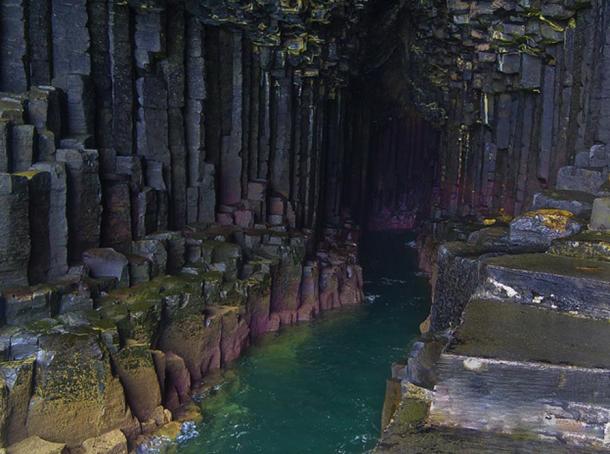Fingal’s Cave: Legends and Inspiration Near the Scottish Sea
Fingal’s Cave is a natural feature located on the island of Staffa, in the Inner Hebrides, Scotland. During the 18th century, Staffa was inhabited by 16 people. Now, no one lives on the island, and it would probably be forgotten, if it were not for the existence of the spectacular site called Fingal’s Cave.
This sea cave has been able to draw tourists to the deserted island for several reasons. Apart from being a geological marvel, Fingal’s Cave is also an important site in Irish legends. Another of the cave’s claims to fame is that, despite being in an uninhabited part of the world, it has been visited by a number of well-known figures over the centuries, and it even served as the inspiration for a concert overture.

Fingal’s Cave, Island of Staffa, Scotland by Thomas Moran, 1884-5, High Museum of Art. ( Public Domain )
The Beauty of Fingal’s Cave
Fingal’s Cave has a height of about 22 m (72.18 ft.) and a depth of about 82 m (269.03 ft.). It has been speculated that Fingal’s Cave is over 50 million years old. As the island of Staffa is situated in an area of volcanic activity , Fingal’s Cave was created by lava flow.
The cave is made up of three layers. The base consists of a layer of tuff and the top is composed of a layer of basaltic lava lacking a crystalline structure. In between these two layers are interlocking colonnades (perhaps as many as 40,000) of black fine-grained Tertiary basalt.

Basalt columns inside Fingal’s Cave. (CC BY-SA 2.0 )
These colonnades make Fingal’s Cave one of the most stunning sea caves in the world. As the colonnades of lava in the middle layer cooled, they “contracted towards each of a series of equally spaced centers” and “solidified into prismatic columns”. The columns that were produced normally had between three to eight sides, with six being the most common.
- Ten Amazing Caves of the Ancient World
- The Obscure Mangiapane Cave in Sicily: Prehistoric Cave and Site of Modern Feasts
- Shelters from the Storm: More Ancient Buddhist Caves Found in Mumbai
The lava flow that created the columns is also said to have been responsible for the formation of the Giant’s Causeway off the northeastern coast of Northern Ireland. It has also been suggested that at some point of time in the past, Fingal’s Cave and the Giant’s Causeway were connected by a ‘bridge’ of the same material. These two sites are not only connected by geological similarities, but also through Irish legend. Both sites are, for one reason or another, connected to the name Fionn mac Cumhail , a renowned warrior in Irish legend .

Sunset at Giant’s Causeway , Northern Ireland. ( aitormmfoto /Adobe Stock)
Fionn mac Cumhail and The Legend of the Giant’s Causeway
According to legend, the Giant’s Causeway was built by Fionn, who, though normally regarded as an ordinary-sized human, is depicted as a giant in this particular tale. This causeway was ‘constructed’ after Fionn was challenged to a fight by a Scottish giant. It served as a meeting point for the two men.

Fionn mac Cumhaill, illustration by Stephen Reid. ( Public Domain )
During the 18th century, there was a popular poetic version of the legend of Fionn written by the Scottish poet James Macpherson. Macpherson said the works Fingal, an Ancient Epic Poem in Six Books and The Works of Ossian were tales about the legendary mythological Irish character named Fingal (Fionn), which he had collected and translated from ancient Gaelic sources. Ossian was based on Oisín, Fionn’s son – the most famous bard in Irish myth. Scholars now believe that Macpherson may have based his poems on authentic Gaelic ballads but likely adapted them to his audience and own interests.

‘Ossian Singing His Swan Song’ (1780-1782) by Nicolai Abildgaard. (CC0)
Naming the Cave
One of the men who had read Macpherson’s works was a British naturalist by the name of Sir Joseph Banks. It was because of Banks that the cave was discovered, or rather, rediscovered. In addition, it was also Banks who renamed the cave.
The cave Banks found was originally called ‘Uamh-Binn’ (which means ‘Cave of Melody’) by the Celts . Influenced by Macpherson’s poems, Banks decided to call the cave Fingal’s Cave, Fingal being the Scottish form of Fionn mac Cumhail.
Famous Visitors to Fingal’s Cave
Many famous people have travelled to Fingal’s Cave over the years. This list includes royalty such as Queen Victoria and Prince Albert, writers such as Sir Walter Scott and Jules Verne , and poets such as William Wordsworth and John Keats. Many artists and musicians have also been inspired by the intensity of the cave.
Perhaps the visitor who made the biggest contribution to the fame of Fingal’s Cave is the German Romantic composer Felix Mendelssohn, who is recorded to have visited the island of Staffa in August 1829. Mendelssohn’s visit to the cave gave him the inspiration to compose a concert overture in the following year, which is aptly named The Hebrides , alternatively known as Fingal’s Cave.
Related Post
A shocking documentary proves that mermaids do exist
SHOCKING Revelation: Thuya, Mother of Queen Tiye, Was the Grandmother of Akhenaten and Tutankhamun—What Ancient Egyptian Secrets Did She Leave Behind?
Breaking News: Astonishing Discoveries at Karahan Tepe Confirm an Extraterrestrial Civilization is Hiding on Earth, and NO ONE Knows!
Breaking News: Researchers FINALLY Discover U.S. Navy Flight 19 After 75 Years Lost in the Bermuda Triangle!
NASA’s Secret Investigation: Uncovering the Astonishing Mystery of the UFO Crash on the Mountain!
Explosive UFO Docs LEAKED: Startling Proof That Aliens Ruled Ancient Egypt!